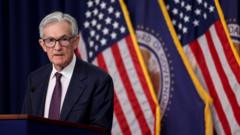The Federal Reserve has decided to maintain its key interest rate at 4.3%, despite expectations of economic slowdown and rising inflation. Officials remain cautious, aiming to gather more data before making policy changes.
Federal Reserve Stays Course on Interest Rates Amid Economic Uncertainty

Federal Reserve Stays Course on Interest Rates Amid Economic Uncertainty
The U.S. central bank holds interest rates steady for the fourth consecutive time, as economic forecasts dim amid tariff tensions.
The Federal Reserve has elected to maintain its key interest rate at 4.3% for the fourth consecutive time, demonstrating a commitment to stability amid a climate of economic uncertainty faced by both businesses and individuals in the United States. This decision arrives as officials revise their forecasts, predicting slower growth and higher inflation rates than previously anticipated.
While borrowing costs are typically adjusted based on economic performance, the Fed's steady approach reflects a desire for more clarity regarding the impact of recent tariff policies and broader economic shifts. Though inflation has surpassed the Fed’s 2% target—recording an annual rate of 2.4% in May—the bank’s officials believe the overall economy remains robust.
In recent comments, former President Donald Trump urged the Fed to lower interest rates, suggesting that economic conditions have improved. However, Fed officials have emphasized their autonomy in decision-making, relying on empirical data rather than political pressure. Despite external calls for action, the Fed warned that average economic growth is expected to decline to 1.4% for the year, while inflation is projected to rise to around 3% with unemployment anticipated to reach 4.5%.
Investment analysts, such as Isaac Stell from Wealth Club, point out that the Fed's stance demonstrates its commitment to maintaining independence from political influence, particularly as Trump voiced his criticisms of Fed Chair Jerome Powell. With the Fed's benchmark interest rate significantly higher than the near-zero rates maintained from 2008 to 2022, its decision will heavily influence lending rates across the economy, affecting mortgages, business loans, and consumer credit.
As other central banks, like the European Central Bank, have opted for rate cuts in response to economic pressures, the Federal Reserve's pause signals a cautious strategy focused on measured responses in a shifting economic landscape.




















